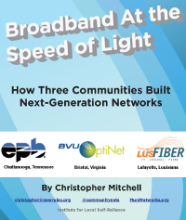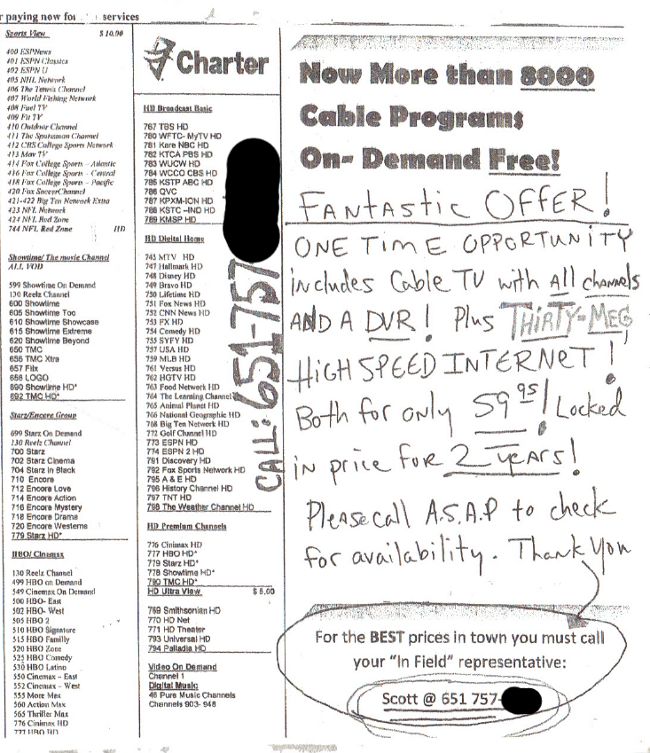
Fast, affordable Internet access for all.

Recently, we let you know about the situation in Siloam Springs, Arkansas, population 15,039. The town is now investigating the possibility of building their own fiber network. They have had several community meetings and a "vote of the people" is set for May 22, 2012.
Pamela Hill is investigating the twists and turrns in a series of articles about the vote. In one of her articles, Hill looked into another Arkansas community, Paragould, home of the annual "Loose Caboose" Festival. This community, located in the northeast corner of the state, has successfully operated their own cable network since 1991. Unlike Siloam Springs, the people of Paragould weren't focused first on generating new revenue for the local government, they just wanted to be able to watch tv for a reasonable price.
Back in 1986, Cablevision was the only provider in Paragould. Hill spoke with Rhonda Davis, CFO of Paragould Light, Water & Cable:
"The public wasn’t happy with Cablevision’s service or rates,” Davis said. “We took it to a public vote and did it.”
Prior to Paragould's decision to build their own network, the City had a nonexclusive franchise agreement with Cablevision. The town was dissatisfied by the service they received and, in 1986, Paragould voters approved an ordinance authorizing the Paragould Light and Water to construct and operate a municipal cable system. Three years later, there was a referendum that authorized the city to issue a little over $3 million in municipal bonds to finance the system.
That same month, Cablevision filed suit alleging antitrust violations, breach of contract, and infringement of first and fourteenth amendment rights. The district court dismissed the antitrust and constitutional claims and Cablevision appealed unsuccessfully. The case attracted attention from lawyers and business scholars across the country.
We have developed a new video to explain why communities consider building their own broadband networks. Please pass it around, embed it in social media, and also remind people that we have a new report with in-depth case studies of community broadband!

David Cameron, city administrator, said the proposal is not so much about dissatisfaction with current providers as it is about finding new revenue for the city. Cameron said revenue from electric services has been a key source of funding for various projects and necessities for the city. That “enterprise” fund is getting smaller, Cameron said, and an alternative funding source is needed. “We have done a good job managing accounts, building a reserve,” Cameron said. “We want to keep building on the programs we have. It takes money and funds to do that.” City officials discussed the issue for the last 18 months and decided to put it to a referendum. Voters will decide the issue May 22.That is a fairly unique reason. Most communities want to build these networks to encourage economic development and other indirect benefits to the community. Given the challenge of building and operating networks, few set a primary goal of boosting city revenue.

If approved by voters, the city plans to spend $8.3 million to install 100 miles of fiber optic cable directly to homes and businesses. The city should be able to repay the debt in 12 years, if things go according to a feasibility study presented to the city’s board of directors in January.
According to the friend, Glenda Dillashaw, a Charter representative told her that Spain would need to find his cable box or be charged $212 for its loss.Fortunately, when Spain followed up with Charter after receiving another bill, the representative told him not to worry about it, suggesting that either Charter has an ambiguous policy to deal with it or Spain found a customer support person who's heart had not yet been crushed by soul-numbing job of being a customer support representative for a massive cable company. At least one other company has a formal policy in place for these situations:
Bright House Networks, whose service area includes hard-hit Pratt City, also expects its customers to file claims under homeowners' or renters' insurance to pay for lost or destroyed cable boxes. "That's how we normally handle it," spokesman Robert L. Smith said.Fascinatingly, an article in Michigan claims Comcast does not have a policy in place for these situations. Following recent tornados in Michigan, Comcast customers who lost their homes were given the option of paying a cancellation fee or paying a reduced "vacation" rate for a service they could not use.

Katherine Pfeiffer and Kathy Crawford soon found that residents were being told that they would be responsible for damaged or lost cable boxes and modems. Initially residents were told their accounts with Comcast would be put on “vacation” status, where a monthly fee of between $15 and $20 would be charged.Comcast is supposedly "working on a solution" for these people. The hubris of this massive companies is unreal. People who are waiting to hear if their home is repairable or has to be destroyed should not be confronted by the cable company with exorbitant fees.
 Download a higher resolution PDF here.
Charter has taken a package for which it charges $145/month in Rochester, Duluth, Lakeville, and nearby Buffalo (MN) and is offering it for $60/month - price guaranteed for 2 years. A Monticello resident supplied us with this flyer, which this person had received multiple times at their home over the course of a month. (See below for the full flyer).
Download a higher resolution PDF here.
Charter has taken a package for which it charges $145/month in Rochester, Duluth, Lakeville, and nearby Buffalo (MN) and is offering it for $60/month - price guaranteed for 2 years. A Monticello resident supplied us with this flyer, which this person had received multiple times at their home over the course of a month. (See below for the full flyer).
 This is either predatory pricing or the cable industry is out of control with its rate increases. If that package costs Charter more than $60/month to supply, then it is engaging in predatory pricing to drive competitors out of the market. Consider that Charter may be taking a loss of $20/month ($240/year) from each household that takes this offer.
This is either predatory pricing or the cable industry is out of control with its rate increases. If that package costs Charter more than $60/month to supply, then it is engaging in predatory pricing to drive competitors out of the market. Consider that Charter may be taking a loss of $20/month ($240/year) from each household that takes this offer.This is a good news/bad news story. The good news is, cable companies are starting to challenge telco dominance in health care communications. According to Bloomberg, they are “ramping up sales staffs to sell broadband access and related services to regional hospitals and doctors’ offices, trying to squeeze more money out of a network they used to use mainly for carrying TV signals.”
The bad news, of course, is that as we transition to digitized medical records, our medical system will be increasingly dependent on the cable/phone duopoly. All companies cited in the article anticipate substantial revenue growth from the health care sector in coming years. Unfortunately, increased revenues to the telecommunications providers means any efficiencies are unlikely to translate into lower health care costs.
Compare this to OneCommunity’s HealthNet, which is driving down costs for health facilities across Northern Ohio by providing affordable access to their gigabit network.
OneCommunity is a non-profit entity that owns and operates its own fiber infrastructure and also promotes interconnection among public and private networks in the region. Its own network is carrier neutral, meaning any service provider can lease access. It connects more than 1,500 entities in 22 counties, including some 65 hospitals. As we've written here, OneCommunity has created enormous cost savings by allowing health care entities to communicate directly with one another, avoiding Internet transport fees.
Photo by therichbrooks on Flickr - used under Creative Commons license.We are running a guest commentary today. Eric Null is a third-year law student at Cardozo Law School in New York City. He is passionate about corporate and intellectual property law, as well as technology and telecommunications policy. Follow him @ericnull or check out his papers. While researching a paper about municipal broadband networks, I was struck by the tremendous benefits that municipal networks can provide. It can be the first high-speed Internet link for an area without broadband, or it can provide some much-needed competition in areas that currently have access to broadband, but for some reason that existing access is unsatisfactory (e.g. price, service). Municipalities, in theory, can run the network for the benefit of the public rather than with a vicious profit maximization motive. Indeed, municipal networks bring many benefits. But first, a little history. In the United States, cable providers have set up regional monopolies for themselves, and “competitors” such as DSL and satellite are characterized by slower connection speeds and it is arguable that they are actual substitutes to cable access. Certainly within the cable industry, any “competitive” cable company attempting to compete with incumbents is met with high costs of building new infrastructure and lack of customer base. Municipalities can pick up where smaller, private entities cannot succeed. Municipalities have had a long history of investing in critical infrastructure, and they have the mentality for long-term planning that private companies simply cannot enjoy. A large company like Verizon likely has to justify any expansion of its network to its investors and ensure them that the venture will return a profit relatively quickly. Not so with municipalities; a city network allows its citizens to benefit indirectly (and directly) over the long-term. Thus, city governments can be a formidable competitor in the telecom and cable industries. Some states, regrettably, have banned or restricted the practice. In Nixon v.
The SCCTA has been actively following the AT&T-backed legislation that would amend the Government-Owned Telecommunications Service Providers Act. House Bill 3508 would impose the same requirements on government-owned broadband operations that are currently imposed on telecommunications operations.Of course, H.3508 goes far beyond applying the "same requirements." It enacts a host of requirements that only apply to public providers, which are already disadvantaged by being much smaller than companies like Time Warner Cable and AT&T. We have long ago debunked the myth of public sector advantages over the private sector. The second quarter newsletter [pdf] identifies this bill as the highest priority of the cable association:
H3508, the AT&T backed legislation, has been our dominate piece of legislation in 2011.